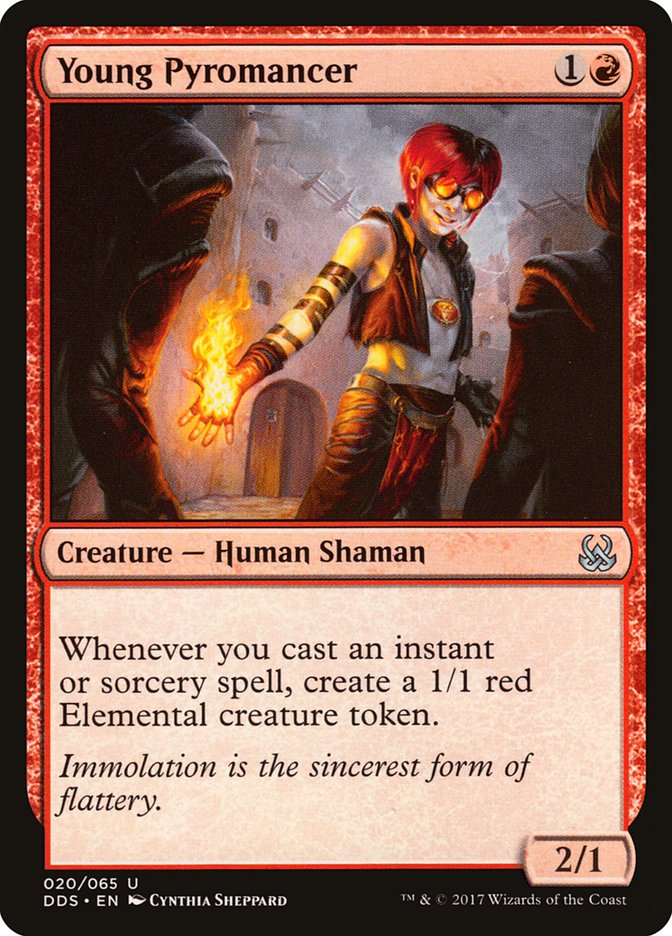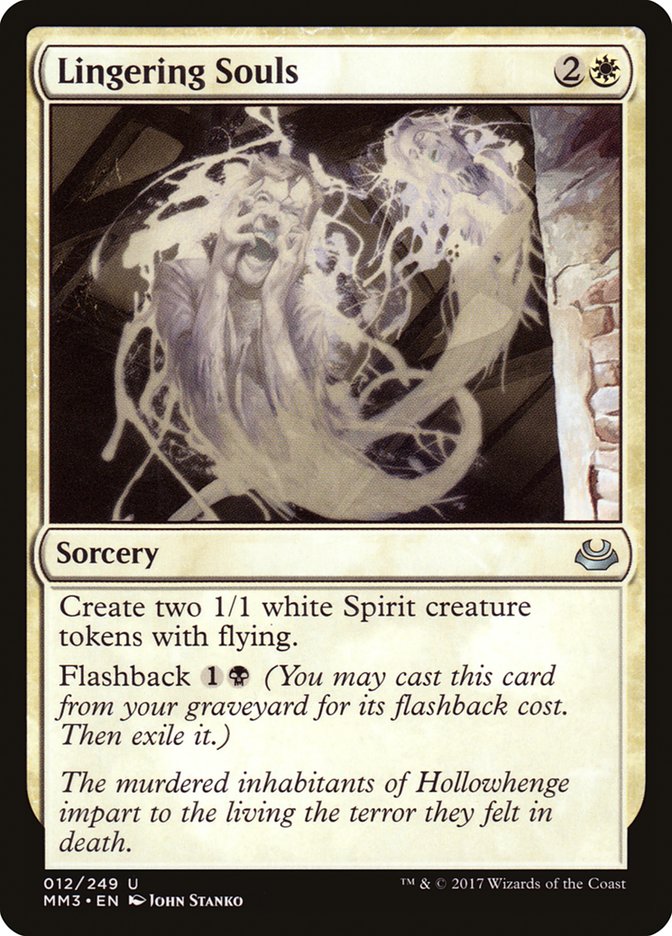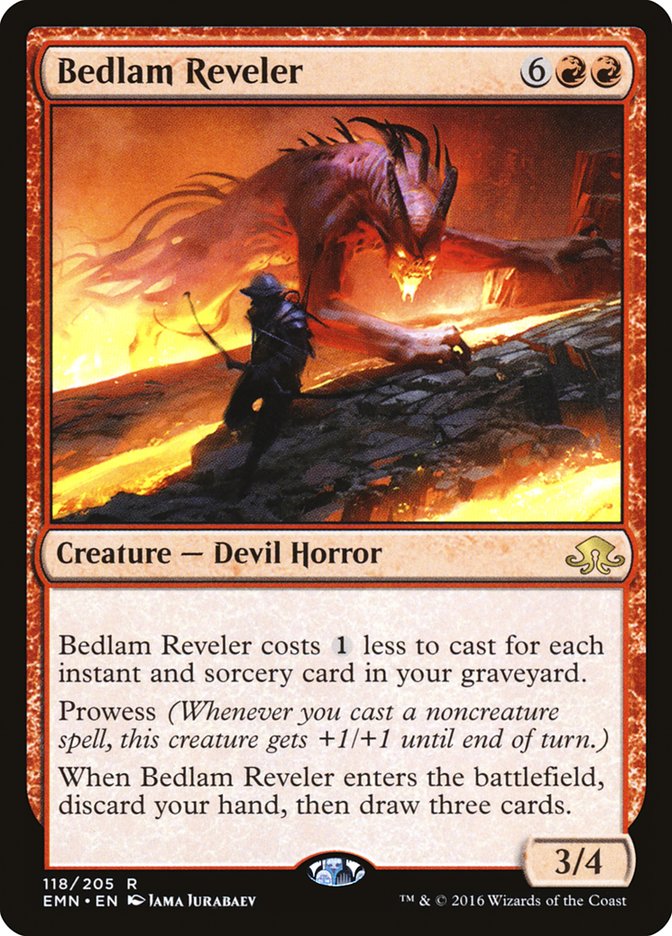My tournament report is the more important piece, but that will have to
wait until next week. I wanted to get this up before Grand Prix Toronto for
all the #marduguys* out there.
At Pro Tour Rivals of Ixalan, I went 9-0-1 in the swiss with Mardu
Pyromancer, eventually losing in the finals. I had a blast playing the
deck, as it combined various strategies I was used to playing, so I was
able to pick it up with little practice. If you’ve played decks like Jeskai
Flash or Jeskai Black, you’ll be able to pick this up pretty easily.
I played this:
Creatures (8)
Planeswalkers (1)
Lands (20)
Spells (31)

This is a fair deck that has some unfair draws. Occasionally it resembles a
Legacy deck. It’s also some of the most fun I’ve had in Modern recently.
My decklist for the Pro Tour was made by scouring the Magic Online
decklists, taking a lot of inspiration from Galan Falakfarsa’s GP Santa
Clara deck, and listening to Mattia Rizzi on some of the finer points.
The goal of any of these velocity-based decks is to use your mana every
turn. Most of the time, you should remove threats first, then draw cards
and deploy threats. Obviously that can change depending on the matchup and
game state, but that’s the gist. Sometimes you get to slip a Young
Pyromancer onto the battlefield in between all of that and get some value.
This is a R/B Midrange deck that will often discard Lingering Souls for
value. Adding white cards to the deck comes at a cost. For example,
splashing for Lightning Helix does very little since you’ll have to take
two damage from a shockland to cast it. Mardu doesn’t deal itself a lot of
damage via its manabase because it’s basically a two-color deck. Over the
course of the tournament, I flashed back Lingering Souls way more than I
hardcast it.
Your sideboard cards are a different story and you can splash them if it’s
entirely necessary. Do you really want to have to fetch Sacred Foundry
early against Burn in case you draw your Kambal? In that case, splashing is
a liability, but against decks where your life total doesn’t matter, it’s
free.
This deck has a slower clock than something like Jund, but you often kill
quickly once you’re in control. Being able to either reload on disruption
or combo kill them with a large Bedlam Reveler are some of the reasons to
play Mardu over something like Abzan.
The Engine
While Mardu Pyromancer functions as a B/X Midrange deck, it also has a
uniquely powerful card drawing engine that makes it difficult to run out of
gas. That feature is incredibly attractive for a midrange deck, plus it
makes the deck a ton of fun to play!
Ideally, this deck wants to cash in its resources for some value and then
gas up with Bedlam Reveler. You can exchange resources with your opponent
by trading one-for-one, filter through dead cards with Faithless Looting,
or discard excess cards to Liliana of the Veil or Collective Brutality. If
this deck isn’t cashing in its useless resources for something else, it’s
probably falling behind. The only catchup mechanism is playing multiple
spells per turn, assembling an army of token blockers, or potentially
winning the game with large Bedlam Revelers.
How many spells you play in the deck is important for Bedlam Reveler and
Young Pyromancer, but you can get away with skimping a bit if you need to,
especially in the sideboard games. The games will go longer, so there’s
less of a necessity to have the quickest Bedlam Revelers. It’s also more
likely that all of your cards will interact with your opponent favorably in
the post-board games, which means you won’t be forced to dig for answers.
The Monastery Swiftspears are an additional clock that Selfeisek played to
get some chip damage in against combo, big mana, and Lantern Control. When
the deck was all Forked Bolts and Burst Lightnings, that plan kind of made
sense, but it’s definitely not a good plan. Overall, I’d prefer to rely on
my sideboard to beat those matchups, but only because of how mopey trying
to beat Tron with Monastery Swiftspears and Forked Bolts is.
The Removal Suite
You want to be able to remove cheap creatures early game, as well as big,
expensive threats in the midgame. Sweepers would make your job a whole lot
easier against decks like Humans, but you can often go toe-to-toe with
them, as I did frequently in the feature match area.
Ideally your removal can be used proactively. Lightning Bolt can go
upstairs, so it fits the bill perfectly. I had played Bedlam Reveler decks
in the past, so I knew how bad it was with purely reactive cards. Discard,
Lightning Bolt, and threats pair much better with it. There’s nothing worse
than sitting on a Mana Leak or Stubborn Denial with Bedlam Reveler in hand
while your opponent refuses to play anything.
Be proactive!
The Land Destruction
Which mana denial aspect you go with is up to you. Foregoing it entirely
could be wise depending on your exact metagame. I’ve already seen a lot of
chatter regarding Tron at Grand Prix Toronto, so I wouldn’t get rid of the
mana denial aspect quite yet.
I basically Blood Mooned zero people at the Pro Tour, so take that for what
it’s worth. Where you want Blood Moon:
- Burn
- Tron
- Eldrazi Tron
- Scapeshift
- Three-Color Midrange, including Death’s Shadow
- Company Humans (on the play)
- Typically U/W Control and various three-color manabases.
Everywhere else, Blood Moon is pretty bad. If Tron didn’t exist, I wouldn’t
have Blood Moon anywhere in my 75.
The Sideboard
Sideboarding and mulliganing are intricate skills, both of which lead to my
success at Pro Tour Rivals of Ixalan. For the most part, this deck
can keep a wide range of hands. Matchups like Humans require you to have
some early interaction, but not much past that. Since most of your deck is
interaction, you’ll end up keeping most hands. Decks like Tron require you
to have very specific disruption, so you’ll mulligan more aggressively
against them.
This version of Mardu Pyromancer was built to handle a very specific
metagame that I outlined last weekend. Decks where your interaction doesn’t
line up aren’t great matchups, but my sideboard was particularly hateful.
Most midrange decks are built under the premise of having versatile cards
in their sideboards that could be brought in against a number of
strategies, but that wasn’t my plan for the Pro Tour. I had specific
targets and happened to nail the metagame.
If I were playing GP Toronto, I would register this:
Creatures (8)
Planeswalkers (1)
Lands (19)
Spells (32)

I honestly think the best list is going to end up playing four copies of
Manamorphose. It’s such a good enabler for Bedlam Reveler and Young
Pyromancer that it makes sense. If you want to try the other two copies, I
would recommend cutting some combination of a Lightning Bolt, the Blood
Moons, the Liliana of the Veil, or a land.
If you have space, try a Darkblast somewhere in the 75 and maybe another
Manamorphose. Grim Lavamancer could also be quite good against creature
decks, but Engineered Explosives mostly does that job better. Kambal,
Consul of Allocation is also sweet in some matchups. A Pithing Needle could
help some of the bad matchups.
It’s a little tougher for a Grand Prix or SCG Tour field where it should be
more open than a Pro Tour, so you kind of have to be prepared for
everything.
Sideboarding Guide for Grand Prix Toronto
As always, sideboarding depends on your opponent’s exact list (or what you
can extrapolate based on the cards you saw and how your opponent played)
and should vary. Using a strict sideboarding guide isn’t ideal because no
two decklists or players will be the same. If you’re just looking for a
guidepost or starting point, that’s what this is here for.
VS Lantern
Out:

In:

Let’s throw the entire kitchen sink at ’em and see what happens.
My new strategy is to disrupt them as much as possible early on, but if
it’s clear the game is going to go on for a long time, it’s better to stop
casting your card drawing spells and fetchlands and save them for a big
turn so you can make their mill rocks ineffective, at least for that turn.
I will likely never know if that’s a better plan all of the time or if it
will vary game to game. The bad part about waiting is how much counterplay
they have to that plan. They can Inquisition of Kozilek away a card drawer,
use Grafdigger’s Cage to stop Flashback on Faithless Looting, and maybe
establish a firmer lock as the game goes on. All signs point to it not
being a great strategy.
In the finals of the Pro Tour, it seemed like the best plan was to race to
find answers, but that also proved ineffective. We have a little more hate
here, which is certainly helpful, and maybe that tips the scales in favor
of the “do some early” plan.
Don’t be afraid to concede early if you have a very small chance of
winning!
VS Tron
Out:

In:

I beat Tron the one time I played it on Magic Online and beat Eldrazi Tron
twice in the Pro Tour (which is admittedly a much easier matchup), but I’ve
been hearing players bemoaning the awful Tron matchup despite the maindeck
Blood Moons and sideboard land destruction.
The matchup isn’t favorable for Mardu Pyromancer by any means, but it’s
much better than the matchup for any B/G deck. At least with Mardu
Pyromancer, I feel like I have a fighting chance.
Ghost Quarter was originally in the sideboard as a fourth Molten Rain
because you could break up Tron while on the draw and get them with
Surgical Extraction. The other land destruction spells were better in more
matchups, so I’m not a fan of playing Ghost Quarter for just Tron.
Out:

In:

Blood Moons can go in and out of the deck after sideboard depending on how
aggressively your opponent is fetching basics. A singleton Surgical
Extraction is fine against Snapcaster Mage decks, but isn’t ideal.
I didn’t have many sideboard cards for this matchup at the Pro Tour, but
Engineered Explosives and Hazoret the Fervent are quite nice.
VS Five-Color Humans
Out:

In:

If they are the Collected Company version, it’s a little tougher, but not
by much. I would basically ignore their Aether Vials which made Blood Moon
pretty bad against them, but without Aether Vial, Blood Moon is quite good
on the play. On the draw you will often be stuck reacting to them and not
have time to deploy it.
Liliana of the Veil is solid against them and could be better than a
Kolaghan’s Command.
VS Burn
Out:

In:

This is not a great matchup, but it wouldn’t take much to sway it in your
direction.
Dreadbore and Terminate are alright, but often too slow in the matchup. The
same is basically true of Kolaghan’s Command. If you don’t have one mana
interaction in your opening hand, you should probably mulligan. You could
make an argument for cutting Manamorphose in the face of Eidolon of the
Great Revel, but unlike Thalia, you need to kill Eidolon on the spot.
Blood Moons are actually fine here, and if you get to remove their
persistent sources of damage, a Blood Moon on turn 3 could gain you upwards
of ten life by shutting off their white cards.
VS B/R Hollow One
Out:

In:

If they don’t have Leyline of the Void, obviously you don’t need the Wear,
but it is another Terminate for Hollow One.
Lightning Bolt isn’t ideal here, but it’s a proactive way to trigger Young
Pyromancer and helps the tokens trade up with bigger threats. You might
also need them to clear away Bloodghast and Flamewake Phoenix in order to
Liliana of the Veil away a Gurmag Angler.
This matchup seems tough, but it’s probably a ton of fun.
VS U/R Gifts Storm
Out:

In:

You should be able to easily lock them out with all your disruption.
VS Affinity
Out:

In:

Liliana of the Veil isn’t ideal here, but it could potentially remove a
pesky Etched Champion. People have told me they like Blood Moon to stop the
creature-lands, but I think that’s nonsense when you have Lingering Souls
in your deck.
If you had more cards to bring in, a Young Pyromancer or two could easily
go. You’re not fighting them on the ground, so it’s poor as a defensive
tool and there are real diminishing returns.
VS Jeskai Control
Out:

In:

Very little changes between a sideboard plan for Jeskai Control and U/W
Control. The tempo Jeskai deck with Geist of Saint Traft is another story,
though.
As is the case with all decks containing Field of Ruin, Ghost Quarter, and
Path to Exile, leave basic land in your deck and fetch dual lands if
possible.
Cutting Lightning Bolt entirely might be poor in the face of Spell Queller.
Fatal Push seems like a better hedge because of Celestial Colonnade. Maybe
an Engineered Explosives should come in because of Rest in Peace or Geist
of Saint Traft? As always, it all depends on what their deck looks like.
Collective Brutality is fine because it snipes Cryptic Command and puts you
out of burn range, but it’s not an all-star or anything.
They will probably fetch basics because of Blood Moon and be very sad when
they get Molten Rained.
VS B/G/X Midrange
Out:

In:

Conventional wisdom says side out the discard here, but this isn’t a
traditional matchup. You have the means to filter through your discard
spells and you don’t necessarily want to be playing draw-go in the early
turns. Remember that Bedlam Reveler requires you to be proactive and the
discard helps with that. As you can see, I very rarely, if ever, sideboard
them out.
Lightning Bolt is either great against a deck with Dark Confidant,
Scavenging Ooze, and Raging Ravine, or it’s very poor against an Abzan deck
with very few targets. The “Out” section is very tentative here.
The same deal with Blood Moon against Grixis Death’s Shadow applies here.
Can your opponent fetch basics without having it hinder them too much? If
so, Blood Moon can go. Just make sure to fetch a basic Swamp early if you
can in order to keep up the ruse.
The Risky Version
If you decide that Tron isn’t an issue or that you’ll concede to it if it
means beating everything else, you get to play this decklist:
Creatures (8)
Planeswalkers (2)
Lands (18)
Spells (32)

The sideboarding strategies will change a little bit, but the core ideas
should be the same. Our new plan against Lantern might be to burn them out.
Leyline of the Void is a strong graveyard hate card, but I don’t really
like it. This deck goes through a bunch of cards, and if it’s going to
topdeck graveyard hate on turn 4, I’d prefer it to be something castable
and high impact. That said, it is the highest impact and worth trying.
The Version of the Future
Maybe Mardu Death’s Shadow is broken. This weekend may have proven that
being proactive with discard and Lightning Bolts alongside the engine of
Faithless Looting, Lingering Souls, and Bedlam Reveler is much better than
some mopey Snapcaster Mages and Stubborn Denials.
Think of all those games I won at one life — What if that were a benefit?
Creatures (14)
Lands (16)
Spells (32)

Two of the spells need to get cut as the decklist is currently 62 cards,
but I want everything that’s included. If there were a gun to my head, I’d
say that either of a Lightning Bolt, a Lingering Souls, or the Collective
Brutalities could go.
My Death’s Shadow deck gets to play Brainstorm, Ancestral Recall, and have
a bunch of grindy elements? Why wasn’t I doing this all along?
This deck has a scant sixteen land and I think that’s great. Faithless
Looting, Street Wraith, and Manamorphose have you seeing a lot of cards per
game. I’m typically in the camp of using your cantrips to dig for action,
not spells, but even sixteen land feels like plenty.
Death’s Shadow and the discard spells make your deck hungry for black mana
early game, whereas Lightning Bolt, Faithless Looting, and Bedlam Reveler
want red mana. Neither Sacred Foundry nor Godless Shrine seems correct, so
I’m actually tied as to whether or not I should play a white dual land.
Hardcasting Lingering Souls is a thing, but we also have four Manamorphose
if it comes to that. The sideboard Wear and Engineered Explosives lose a
little value, but that’s about it.
Good luck in Grand Prix Toronto and SCG Indianapolis the following weekend!
I won’t be at either, but I’ll be watching for my fellow #marduguys. If
there are any questions or something I didn’t cover, I’ll try to answer
before the GP starts.
*#marduguy isn’t politically correct and I’m taking applications for
something that’s more gender neutral.





